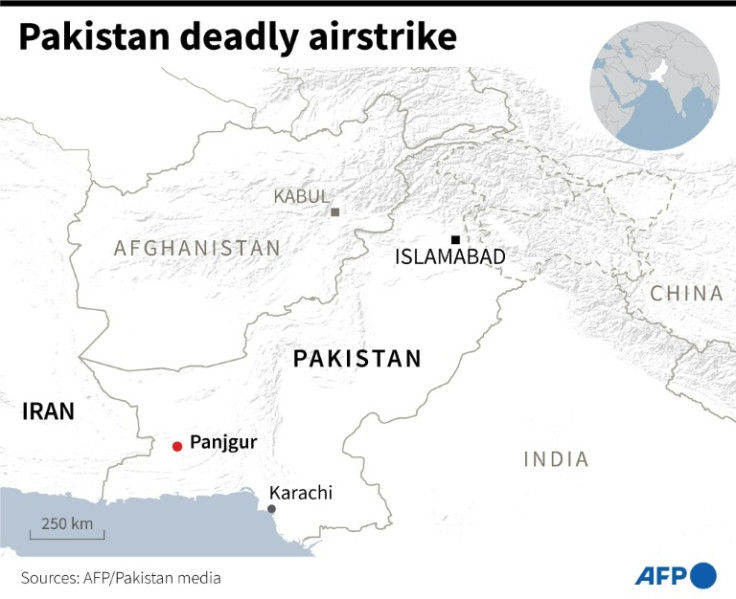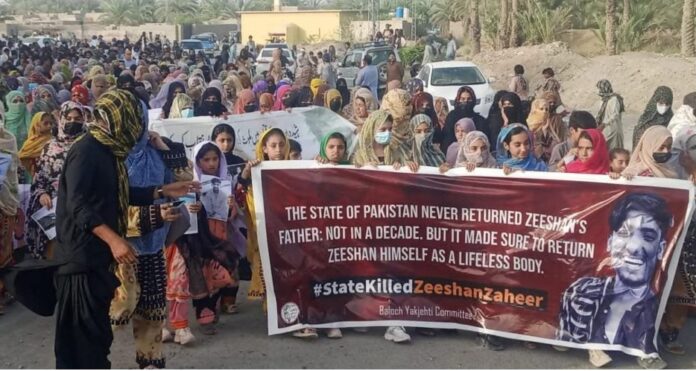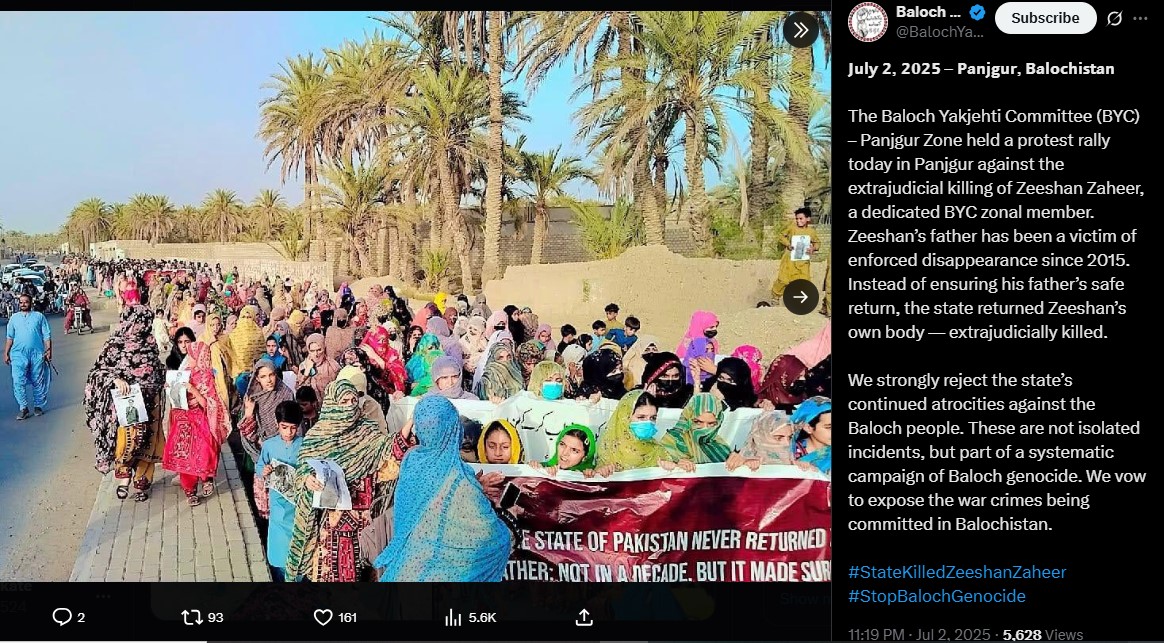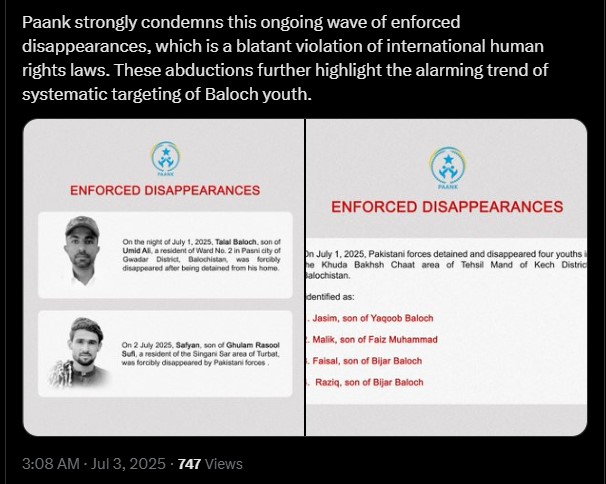Panjgur, Balochistan —
On July 2, people in the Khudabadan area of Panjgur came together for a protest rally and a silent walk. It happened after the shocking death of 21-year-old Zeeshan Zaheer. His body, full of bullet wounds, was found just hours after he was reportedly taken away by a group linked to the state.
The protest was organized by the Baloch Yakjehti Committee (BYC), and many local people joined in. They demanded justice and strongly criticized what they called “state terrorism.”
“The state and its sponsored groups have destroyed peace in Balochistan,”
one speaker declared during the demonstration at Mowach Bazaar.
“Fear and intimidation are spreading due to ongoing state policies.”
“This is a household where the head of the family has been forcibly disappeared for ten years, and now his only son, who was peacefully campaigning for his father’s recovery, has been mercilessly killed,” said Sammi Deen Baloch, a central leader of BYC. “A law of the jungle prevails here, where human life, dignity, and voices are being ruthlessly crushed.”
(Source- ANI )
Who Was Zeeshan Zaheer?
Zeeshan Zaheer was a 21-year-old Baloch youth who became a symbol of resistance in Balochistan. After his father, Zaheer Ahmed, was forcibly disappeared by Pakistan’s Frontier Corps in 2015. Zeeshan, then just 11 years old & began a lifelong struggle to demand his father’s safe return. He actively joined protests, long marches, and awareness campaigns, becoming a known face in the Baloch movement against enforced disappearances.
What happened to Zeeshan on June 29?
-
Abduction Location: Zeeshan was abducted from Football Chowk in Panjgur while returning home after playing a football match.
-
Eyewitness Accounts:
-
Two vehicles intercepted him.
-
He was publicly beaten, his hands tied, and he was dragged into one of the vehicles.
-
-
Immediate Public Reaction:
-
That night, his family and residents blocked the CPEC highway, demanding his safe release.
-
-
Body Found:
-
By the next morning, his dead body was discovered near Ghareeb Nawaz Hotel.
-
-
Condition of the Body:
-
He had been shot six times.
-
Stab wounds were visible.
-
His body showed clear signs of torture.
-
Sammi held the Pakistani state “fully responsible” and warned that politically active Baloch youth were increasingly being abducted and murdered. She called this a form of “institutionalized repression” and urged the public to resist.
Protest and Public Outcry
Following his death, the Baloch Yakjehti Committee (BYC) organized a protest in Mowach Bazaar, condemning what they described as “state-sponsored killings” and the rising influence of “death squads” in the region. A silent walk was also held in Zeeshan’s memory, from Mowach Chowk to Kahoor Cemetery, attended by grieving locals and fellow activists.
“The state and its sponsored groups have destroyed peace in Balochistan,” one protest speaker declared. “Fear and intimidation are spreading due to ongoing state policies.”
BYC and Paank Respond with Outrage
In an official statement posted on X (formerly Twitter), the BYC Panjgur Zone said:
“The Baloch Yakjehti Committee (BYC) – Panjgur Zone held a protest rally today in Panjgur against the extrajudicial killing of Zeeshan Zaheer, a dedicated BYC zonal member. Zeeshan’s father has been a victim of enforced disappearance since 2015. Instead of ensuring his father’s safe return, the state returned Zeeshan’s own body — extrajudicially killed.”
The Committee categorically rejected the continued atrocities against Baloch people and framed the killing as part of a larger campaign of Baloch genocide. The BYC vowed to expose what it called “war crimes being committed in Balochistan.”
Surge in Enforced Disappearances: A Pattern Repeating
Meanwhile, Paank, the Human Rights Department of the Baloch National Movement (BNM), also raised alarms over a spike in enforced disappearances. In a separate post on X, Paank reported:
“Surge in enforced disappearances across Balochistan – Between July 1 and 2, 2025, at least six young Baloch men were forcibly disappeared by Pakistani forces in multiple districts of Balochistan.”
Such incidents reflect decades of systemic repression in the region. Human rights groups have consistently accused Pakistani authorities of abducting civilians in Balochistan without due process.
“These enforced disappearances are used to suppress dissent and intimidate communities in restive areas,”
said one human rights statement. While Pakistani authorities routinely deny these claims, civil society groups continue to condemn the role of security forces in targeting students, political workers, and residents.
The Iran-Pakistan Connection: Why It Matters in Balochistan

(Source: AFP)
The current crisis unfolds amid historic tensions along the Pakistan-Iran border, where Baloch communities reside on both sides. This division dates back to colonial times when the British handed Western Balochistan to Iran after World War I, fracturing the ethnic unity of the Baloch people.
In January 2025, tensions flared when Iran accused non-state actors from Pakistan’s Baloch region of launching cross-border attacks. Pakistan retaliated with air strikes on Iranian territory on January 18, reportedly killing at least nine people. Both countries eventually stepped back from the brink, reestablishing diplomatic ties.
Amid these hostilities, both Iran and Pakistan claim to have killed members of the militant group Jaish al Adl and Baloch separatists. However, the real casualties remain ordinary Baloch civilians caught in the crossfire.
Historical Roots of Resistance and Repression
The roots of repression date back to the 1970s, when Pakistan’s federal government, under Zulfikar Ali Bhutto, crushed the elected National Awami Party (NAP) in Balochistan at the behest of the Shah of Iran. This crackdown led to the first major Baloch guerrilla resistance movement and a long cycle of military operations, migration, and systemic marginalisation.
Iran also attempted to dilute the ethnic majority in Sistan-Balochistan by resettling other tribes — a strategy likened to Israel’s demographic policies in Palestine.
Despite bilateral trade continuing across towns like Taftan, Gwadar, Kech, Panjgur, and Washuk, the border remains a zone of tension. Experts warn that if conflict reignites, it could devastate both economies and disrupt vital oil and trade routes.
A Flicker of Hope: People’s Movements Rise
While powerful countries play their political games, real hope lies in people’s movements. In Iran, mass protests led by women erupted in September 2022 after the death of Mahsa Amini, a 22-year-old Kurdish-Iranian woman who died in the custody of Iran’s morality police for allegedly not wearing her hijab properly. Her death sparked a nationwide movement demanding justice, freedom, and women’s rights. In Pakistan, hundreds of Baloch families — many led by women — marched from Turbat to Islamabad in late 2023, protesting against enforced disappearances and extrajudicial killings. These protests, driven by ordinary citizens, reflect growing frustration and bravery in the face of oppression. As civil society continues to speak out, the painful question remains: how many more lives will be lost before peace and dignity return to Balochistan?
(Inputs -ANI & Balochistanpost)











